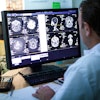Dear Imaging Leaders Insider,
A large study encompassing 38 children's hospitals and more than 12 million pediatric emergency department visits revealed significant differences in imaging utilization among racial and ethnic groups.
The results suggest the need for hospital-level interventions to improve equity in the imaging of pediatric emergency medicine patients, according to the multi-institutional research team. You can read all about their study in this edition's Insider Exclusive.
The global shortage of CT contrast agents triggered by lockdowns at a GE Healthcare facility in China has significantly impacted radiology operations over the last couple of months. Sandy Coffta of Healthcare Administrative Partners assesses the impact of the shortage on imaging practices in a new column.
As we go to press, good news on the shortage came in the form of an update from GE stating that the company expects contrast production at its plant in China to reach close to 100% sometime next week.
Until then, check out some tips from a recent webinar hosted by the RSNA on how to deal with the shortage. In addition, the Greater New York Hospital Association provided members with a list of steps they can take to preserve contrast. A number of other sources have also shared suggestions on coping with supply interruptions.
In other news, radiologists who testify as expert witnesses in medical malpractice cases have similar qualifications regardless of the side they're working for, according to a recent study.
A woman's race and education level can affect how they view the quality of mammography reports and how much they trust their radiologist, according to a talk at the Society of Breast Imaging/American College of Radiology (SBI/ACR) symposium. Also, a community outreach program can be quite helpful in reducing racial disparity among women receiving breast cancer screening.
Another talk at the SBI/ACR meeting described how radiologists can create more inclusive environments by recognizing implicit biases. In addition, efforts to prevent physician burnout should focus on redesigning work processes.
In Canada, an investment of $1.5 billion Canadian ($1.2 billion in U.S.) in federal funding will be needed over a five-year period to update the nation's "inadequate and outdated" inventory of medical imaging equipment, according to the president of the Canadian Association of Radiologists.
Our annual SalaryScan survey is always one of the most popular articles of the year on AuntMinnie.com. Radiologists and radiologic technologists (RTs) both earned higher average salaries in 2021, and RTs even reached a new milestone, according to SalaryScan data.
Adoption of artificial intelligence in MRI applications is more likely to increase demand for radiologic technologists than hurt the profession, according to a recent presentation at the annual meeting of the International Society for Magnetic Resonance in Medicine. Also, a web-based application can facilitate safety assessments of MRI exams.
Black Americans living in rural areas are more vulnerable to dying of lung, prostate, breast, and colorectal cancers than their non-Black peers. And about half of patients flagged as being at high risk of lung cancer after CT lung screening experienced delays in follow-up care.
Rebecca Farrington of Healthcare Administrative Partners also reviews some of the regulatory policies that will change when the COVID-19 public health emergency finally ends.
Is there a story you'd like to see covered in the Imaging Leaders Community? Please feel free to drop me a line.




















